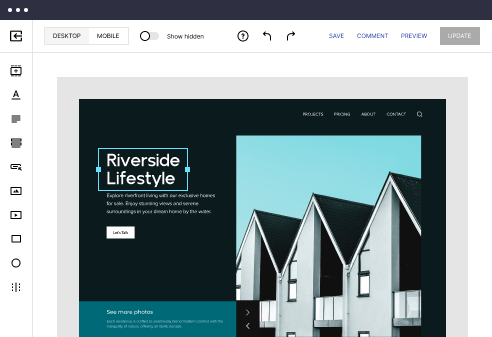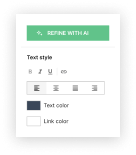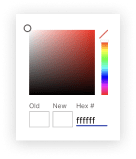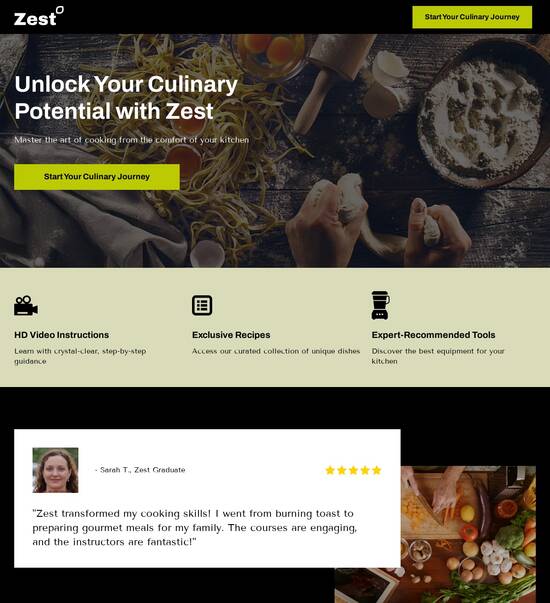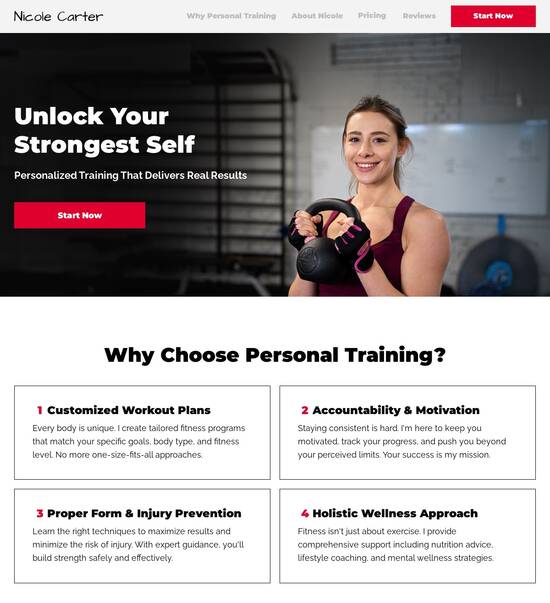
Vue.js optimized mobile page templates
Use TemplateAbout template
Manage Vue.js optimized mobile page templates in a few clicks. Achieve business success with user-friendly and comprehensive no-code tools.
Recommended templates
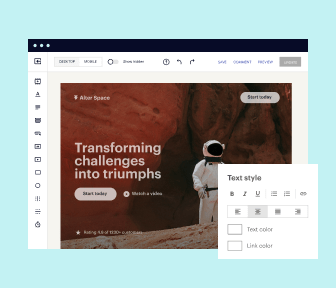
Easy to build without coding
With the intuitive drag-and-drop builder, anyone on your team can create high-converting pages without any knowledge of code or design. Make enhancements to your landing page with custom widgets using Javascript, HTML/CSS, or third-party scripts.
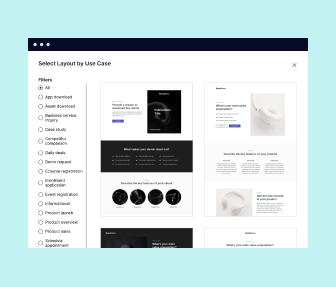
Multiple layouts for any industry and goal
Select from 500+ landing page layouts built to boost conversions across industry-specific scenarios. Customize them by adjusting fonts, adding images, and generating on-brand content with the AI assistant. Quickly scale with Instablocks® and Global Blocks that you can save, reuse, and update globally.
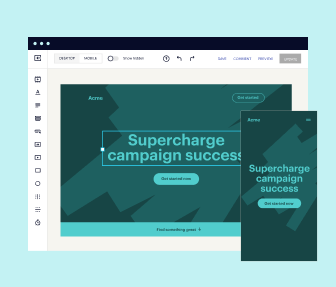
Loads fast and looks polished on any device
Every template is responsive, which means they present professionally on any device and load blazingly fast with our Thor Render Engine. You can also power them up with Google AMP technology to deliver an unparalleled mobile experience and drive higher conversions.
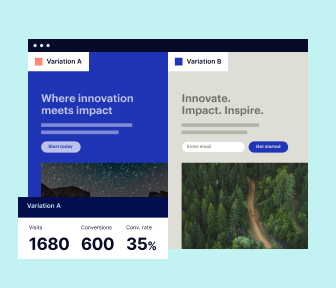
Robust analytics & experimentation
Get real-time updates and reporting across all your devices, showing the number of visitors, conversions, cost-per-visitor, and cost-per-lead. Launch AI-powered experiments, run A/B tests, and use heatmaps to analyze user behavior, then optimize your landing page to maximize conversions.
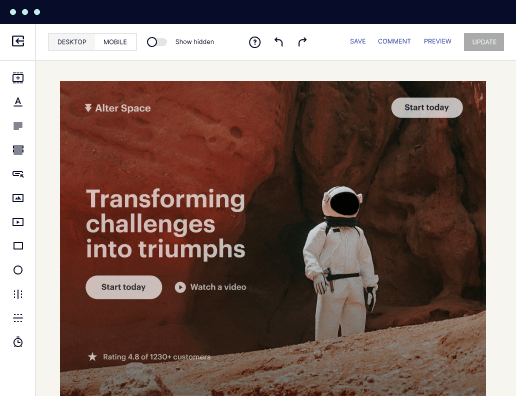
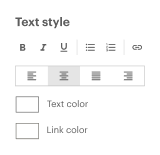
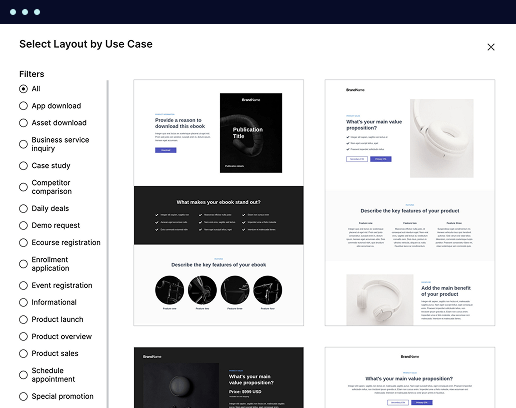
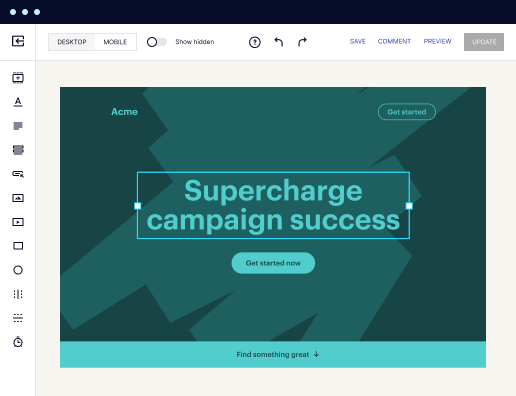

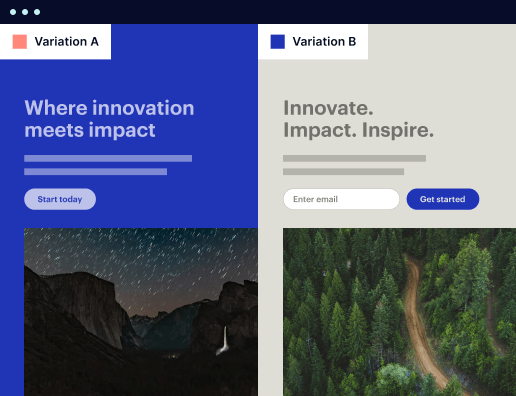

Easy to build without coding
With the intuitive drag-and-drop builder, anyone on your team can create high-converting pages without any knowledge of code or design. Make enhancements to your landing page with custom widgets using Javascript, HTML/CSS, or third-party scripts.
Multiple layouts for any industry and goal
Select from 500+ landing page layouts built to boost conversions across industry-specific scenarios. Customize them by adjusting fonts, adding images, and generating on-brand content with the AI assistant. Quickly scale with Instablocks® and Global Blocks that you can save, reuse, and update globally.
Loads fast and looks polished on any device
Every template is responsive, which means they present professionally on any device and load blazingly fast with our Thor Render Engine.
Robust analytics & experimentation
Get real-time updates and reporting across all your devices, showing the number of visitors, conversions, cost-per-visitor, and cost-per-lead. Launch AI-powered experiments, run A/B tests, and use heatmaps to analyze user behavior, then optimize your landing page to maximize conversions.
All the features you need to build page builder vue
Explore more featuresLearn how to build vuejs website templates
Frequently asked questions about best vuejs templates
Leading the way in building high-performing landing pages





Page builder vuejs: Your ultimate how-to guide
Instapage's landing page and conversion rate optimization (CRO) platform is a pivotal tool for marketers aiming to enhance their digital marketing strategies. This guide will detail the step-by-step process of effectively using Instapage to optimize landing pages and maximize the return on investment (ROI) for your campaigns, particularly within the USA's competitive landscape.
An introduction to Instapage
With over 100 high-converting templates and user-friendly design capabilities, Instapage transforms the way businesses approach marketing. Whether you’re launching campaigns in business services, tech, or education, the adaptive landing pages help tailor your messaging and connect with targeted audiences.
- Flexibility: Instapage allows quick adjustments to pages based on performance metrics, removing the need for extensive coding skills.
- Collaboration: The platform promotes seamless teamwork through real-time editing and feedback features, essential for large marketing departments.
- Analytics: Integrated analytics provide deep insights into user behavior enabling marketers to optimize strategies efficiently.
An step one: Selecting the right template
Choosing a template is crucial to your campaign’s success. Start by evaluating your audience and campaign goals before diving into Instapage's vast library. Pay attention to industry-specific templates that resonate with your audience’s needs.
An step two: Customizing your landing page
Once you’ve selected a template, utilize Instablocks features to customize text, images, and lead generation elements. Consider these elements:
- Dynamic text replacement: Personalize your message based on the source of the traffic to increase conversion rates.
- Lead captures: Use strategically placed forms to gather valuable information without overwhelming your visitors.
- Visual alignment: Ensure that design elements are cohesive with your existing branding to maintain a professional appearance.
An step three: Optimize for conversion
Optimization is an ongoing process. Use A/B testing features to experiment with different versions of your page.
- Heatmaps: Analyze where users engage most on the page to improve layout and content placement.
- Performance reviews: Regularly check analytics dashboards to assess the effectiveness of different page elements.
- Feedback loops: Implement user feedback into design iterations for continuous improvement.
By following these steps, you will be well on your way to maximizing the effectiveness of your Instapage landing pages.
Ready to enhance your digital marketing strategy? Start optimizing your landing pages with Instapage today to boost your ROI significantly!
People also ask about vue mobile template
Vue.js optimized mobile page template: A comprehensive guide
The architecture of Vue.js optimized mobile page template: A deep dive
Understanding Vue.js: The backbone of modern web development
Vue.js has emerged as a significant player in web development, primarily due to its simplicity and flexibility. Originally created by Evan You, Vue.js allows developers to build interactive, single-page applications (SPAs) effortlessly. Its reactive data binding and component-based architecture mean that developers can keep track of state changes more efficiently than with many other frameworks.
What makes Vue.js stand out among frameworks is its progressive nature. Developers can adopt it incrementally, integrating with existing projects or using it to build a project from scratch. Moreover, the framework's ecosystem, including libraries like Vue Router for routing and Vuex for state management, allows developers to craft polished applications, especially optimized for mobile.
Progressive framework allows easy integration
Component-based structure supports reusability and modularity
Reactive data binding improves efficiency and responsiveness in apps
Why mobile optimization matters: The evolving landscape
In recent years, mobile usage has skyrocketed. According to recent statistics, mobile devices account for over half of global web traffic. This shift in user behavior necessitates the optimization of web applications for mobile, as a significant majority now rely on their smartphones for browsing and purchasing decisions.
User experience is directly correlated with mobile optimization; a poorly optimized mobile page can lead to high bounce rates and unsatisfactory engagement. The ramifications aren’t just limited to user satisfaction; companies may suffer financially if their pages are not mobile-friendly.
Despite the importance of mobile optimization, developers face numerous challenges when creating pages that perform well on mobile. Issues like slow loading times, cluttered designs, and broken layouts can hinder the overall experience. Therefore, a well-structured Vue.js mobile page template becomes essential for success.
Crafting the ideal Vue.js mobile page template
An effective mobile page template in Vue.js revolves around essential design components that cater to user needs. First and foremost is the navigation menu. Clear and concise navigation enhances user experience by making it easy for visitors to find what they need without unnecessary clicks.
Moreover, implementing responsive grids is crucial. These grids adapt fluidly to different screen sizes, ensuring that the layout looks appealing on all devices. Touch-friendly elements—such as buttons and forms—are equally vital, as they must be usable on touchscreen devices.
Navigation menus: Ensuring clarity and usability
Responsive grids: Adapting to varying screen sizes
Touch-friendly elements: Enhancing interaction
Structuring a Vue.js mobile page template requires attention to detail. Breaking down the template into components enhances maintainability. Each component should be designed with performance in mind, ensuring that load times remain swift, providing users with the best experience possible.
Component-based architecture in Vue.js
Vue's component system is a cornerstone of its architecture, supporting modular design, which facilitates ease of updates and debugging. By creating reusable components, developers can maintain consistency across their applications and simplify the development process.
Case studies of successful applications utilizing componentization reveal how businesses have optimized their web experience. Notably, applications designed with Vue.js components not only perform better but also provide a smoother user experience—a vital factor in keeping users engaged.
Supports modular design that simplifies the development process
Promotes the reuse of code, enhancing efficiency
Facilitates debugging and testing through isolation
When it comes to component structure, both synchronous and asynchronous components play a significant role. Synchronous components are loaded right away, while asynchronous components can boost performance by being loaded on-demand. A simple example could be a modular sidebar menu that loads with the app only when the user interacts with a specific button.
Leveraging Vue Router for seamless navigation
Vue Router is a powerful tool that enhances navigation within Vue.js applications. It allows developers to implement dynamic routing, which is essential for creating a piggybacking experience on mobile devices. Particularly, the ability to create nested routes supports complex application structures that can cater to diverse user needs.
When implementing routing in mobile templates, it’s crucial to account for browser capabilities. This involves ensuring that navigational elements are accessible and easy to use on touch devices. Ultimately, good routing practices improve user experience, reducing the likelihood of users abandoning a page due to frustration.
Implement dynamic routing for user-specific experiences
Utilize nested routes for complex app structures
Assess browser capabilities for better accessibility
Cross-browser compatibility: Challenges and solutions
Mobile web development presents unique challenges related to cross-browser compatibility. With numerous mobile browsers—including Chrome, Safari, Firefox, and others—ensuring consistent rendering across platforms is crucial. Developers often find themselves troubleshooting layout issues or functionality differences that can arise from varying browser capabilities.
To maintain a uniform user experience, strategies such as fallback solutions and feature detection can be helpful. Resources like CSS resets and browser compatibility tables empower developers to preemptively address potential discrepancies in rendering.
Testing on multiple browsers during development
Implementing fallback solutions for unsupported features
Utilizing CSS resets to ensure consistency
Community contributions and support
The Vue.js community is a robust network that provides invaluable support through various forums, Discord channels, and GitHub repositories. Engaging with these communities can lead to discovering best practices and innovative techniques for mobile optimization. Many developers willingly share insights and solutions that enhance mobile page templates.
Accessing plugins and libraries specifically designed for Vue.js can significantly enhance the capability of a mobile page template. For instance, libraries that help manage forms or improve animations can bring a mobile application to life in ways that standard functionalities may not allow.
Participation in community forums for knowledge sharing
Utilizing GitHub repositories for library access
Learning from successful case studies shared by developers
The role of automated testing in Vue.js applications
Automated testing is vital for ensuring the functionality and performance of any mobile page. By utilizing tools like Jest or Mocha, developers can set up test suites that cover a range of scenarios, from unit tests on individual components to end-to-end tests that validate the entire application flow.
An effective testing strategy not only helps to uncover bugs before deployment but also ensures that updates and new features do not adversely affect existing functionality. Instilling a culture of testing within the development process can lead to more reliable and maintainable mobile applications.
Implementing unit tests to catch bugs early in development
Using end-to-end testing for comprehensive coverage
Encouraging a testing culture in development teams
Return on investment (ROI) from optimized mobile templates
Investing in optimized mobile page templates can lead to significant returns. Websites that focus on mobile optimization see enhanced user engagement and improved retention rates. Detailed analytics provide insights into user behavior, helping marketers adjust strategies to cater to mobile users specifically.
Case studies have illustrated the direct correlation between mobile-optimized pages and conversion rate improvements. For instance, brands that implemented streamlined mobile experiences often saw a substantial uplift in sales after making design adjustments.
Increased user engagement leading to higher conversions
Direct correlation between speed and user satisfaction
Analytics to track performance and areas for improvement
Addressing common questions and misconceptions
Many people wonder why Vue.js is preferable for mobile page templates. Its lightweight nature and flexibility make it ideal for mobile. Additionally, some may have misconceptions about its performance capabilities; however, Python and other backend technologies can seamlessly integrate with Vue.js for high-performing applications that serve mobile users.
Another common question is regarding the learning curve associated with Vue.js. While it may seem daunting, many developers find that the framework's clear documentation significantly simplifies the onboarding process. By leveraging libraries and plugins, developers can speed up their projects without getting bogged down by the intricacies of mobile development.
Benefits of using Vue.js for mobile optimization
Integration strategies with existing backend technologies
Simplified onboarding through clear documentation and community support
Collaborating effectively with development teams
For a successful Vue.js project, effective collaboration among team members is paramount. Establishing clear communication channels ensures that all team members are aligned on goals, deadlines, and coding standards. Tools like Git can facilitate version control, enabling team members to track changes and manage project collaboration seamlessly.
To streamline workflows, making use of project management tools helps teams keep track of their tasks and schedules. Regularly scheduled meetings also promote transparency, ensuring that everyone is aware of project progress and any issues that may arise.
Establishing clear communication for team alignment
Utilizing version control tools like Git
Implementing project management tools for task tracking
Innovative features in Vue.js mobile page templates
Innovation is at the forefront of mobile web development, and Vue.js is no exception. With a plethora of libraries and plugins designed specifically for its ecosystem, developers have access to tools that enable them to create customized experiences tailored to their audience.
Keeping an eye on emerging trends is essential for staying relevant in the competitive mobile landscape. Features like Progressive Web Apps (PWAs) and working with server-side rendering can help make mobile pages not just functional but outstanding.
Exploring new libraries for enhanced functionality
Embracing trends like PWAs for mobile optimization
Utilizing server-side rendering for improved performance
Real-world examples of Vue.js mobile page templates
Examining real-world applications of Vue.js can provide invaluable insights. Numerous companies have turned to Vue.js for their mobile web solutions, achieving impressive results. A breakdown of these applications reveals shared design features, performance enhancements, and user engagement strategies.
Analyzing competitor applications can elevate your own mobile projects. By adopting successful practices and avoiding common pitfalls, you can ensure that your mobile web experience stands out.
Reviewing successful Vue.js applications for best practices
Identifying shared design and performance features
Learning from competitors to improve your mobile offerings
Future trends and predictions in mobile web development
The future of mobile web development is set to be shaped by technological advances and user expectations. As mobile usage continues to dominate, Vue.js will play a central role in ensuring that developers can build responsive and highly optimized applications.
Accessibility and inclusivity are also becoming increasingly important. Future mobile applications will prioritize diverse user needs, ensuring that everyone can access services and content seamlessly. By staying abreast of these trends, developers can prepare for a web environment that values both performance and user experience.
Technological advances enhancing mobile web experiences
Increased focus on accessibility in app development
Preparing for a competitive and rapidly evolving web environment
Ready to skyrocket conversions?
Supercharge your ad campaigns with high-performing landing pages
Get started